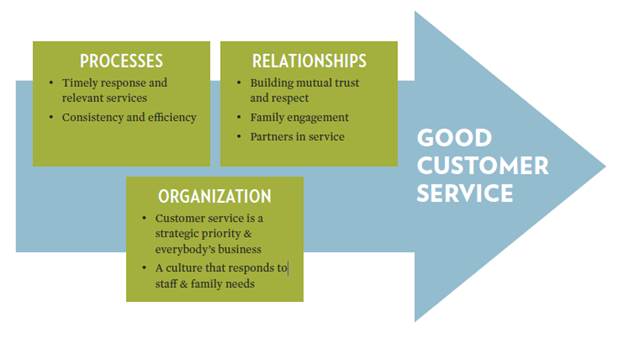Did you know?
Good customer service is everybody’s business in child welfare—ranging from the reception desk all the way to the administrator’s office. It is a key foundation for achieving safety, permanency, and well-being outcomes for the children and youth being served. The PRO Framework (see diagram below) depicts processes, relationships, and organization as key factors that support good customer service in child welfare. Clearly, the processes in which we engage and the relationships we forge are vital components. However, a total organizational commitment from the top down and from staff members at all levels is fundamental to assuring an agency implements good customer service for both internal and external customers.
***************************************************
Did you know?
Child welfare is a professional public service. Providing good customer service in child welfare is both professional and proactive.
PROfessional
- Customer service competencies are congruent and compatible with professional social work values and best practices.
- Customer service core competencies can be taught and applied throughout the agency. They are the building blocks of strengths-based practice.
PROactive
- Good customer service involves: Continuously scanning the environment to hear the voices of customers
- Anticipating customer needs
- Going the extra mile in responding to customer needs
***************************************************
Did you know?
As we apply concepts from customer service to child welfare work, the term “customer” takes on a slightly different meaning than it does in interactions between a business and a customer who purchases goods or services from that business. In the context of child welfare work, there are two categories of customers:
- External customers are the people you do business with outside of your agency. They are the people you serve, collaborate with, and with whom you interact and share your expertise. They include children, youth, birth parents, and extended family members. External customers also include courts and legal professionals, Tribes, contract agencies, cross-system collaborators, advocates, and other community partners.
- Internal customers are the people you work with throughout your agency. They are colleagues, staff members in other agency divisions, and other peers who provide services to you or to whom you provide services (e.g., the financial department staff, licensing workers, data staff, etc.). Put more simply, every staff member within the agency, from the custodian to the highest level administrator, is an internal customer.
Both internal and external customers have expectations about what their relationship and experience with an agency should be, and expectations of what services an agency should provide.
As agencies consider how the term “customer” applies to foster, adoptive, and kinship families, they should recognize the unique role that these families play in the child welfare field and the unique relationship that families have with child welfare agencies. These families have characteristics of both internal and external partners, which means they experience being internal and external customers—sometimes simultaneously—depending on the status of their relationship with the agency and the dynamics of each care-giving situation. They are both an external resource to be sought out and treasured, and an internal partner to be respected as an essential member of the child and family serving team. Even when functioning as internal partners, caregivers generally hold less power than agency staff and are more vulnerable due to the emotional and legal complexities inherent in their status.

